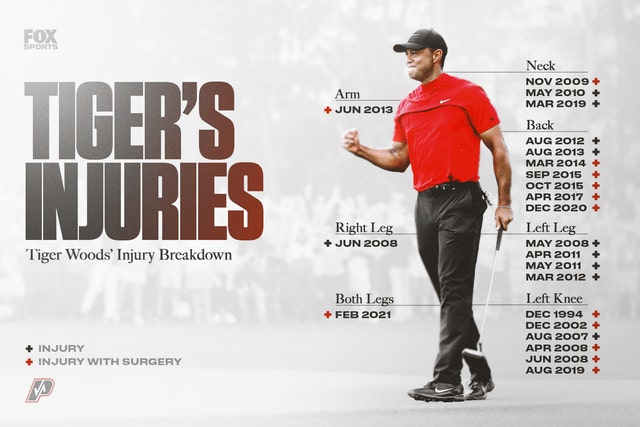
Dr. Matt Provencher breaks down Tiger Woods' injuries and what's next
On Tuesday, the sports world stood still.
Tiger Woods survived a serious single-car accident in suburban Los Angeles that resulted in severe leg injuries and required surgery.
Woods is now at Cedars-Sinai Medical Center continuing to recover.
Following the accident, Dr. Matt Provencher, FOX Sports' injury and performance analyst and former New England Patriots team physician, broke down Woods' injuries, the recovery concerns and the golfer's future in the sport.
What were Woods' injuries?
Woods sustained an injury to his right lower leg, the one typically used to control gas and brakes in cars. As such, his right leg bore the brunt of the force to his body in the accident.
Woods' overall injury pattern resembles what is common in high-speed motor vehicle injuries.
According to Dr. Provencher, though not fully confirmed, Woods' injuries include:
- Open tibia and fibula fractures, compound and comminuted in nature. Compound means the bones were through the skin, and comminuted means they were not "clean" breaks, and the bones had numerous fragments.
- Injuries to his ankle and foot area. Though this is still unclear, Woods might have had an ankle fracture, an injury to the bone that supports the ankle (the talus) or an injury to the midfoot, called a Lisfranc injury. Any of these could affect ankle mobility and function.
- Damage to the soft tissues surrounding the tibia. The fractures Woods sustained cause injuries to the skin and muscles of the calf. Also, blood from the injured bones and muscles can cause the calf compartment to swell.

Woods fractured both the tibia and fibula in his right leg, and it has been reported that the tibia was open (bone through the skin) and comminuted (broken in multiple pieces). This is the typical location for a break in the tibia and fibula in this kind of fracture. A surgical rod was used to stabilize Woods' leg.
Woods had a titanium nail placed in his tibia, a common treatment for this kind of fracture. Nails are typically permanent and biocompatible (hence, made of titanium), and they stabilize the bone. The nail restores the tibia to its natural length and controls rotation, ensuring the tibia is aligned with the ankle and foot bones.
Woods had his calf compartment released during surgery. That was likely due to swelling in the calf, which can suffocate the muscle from blood flow and cause necrosis (death) of the muscle tissue — which is dangerous and irreversible — or as a preventive measure to avoid compartment syndrome, which is important for successful recovery.
What are some other concerns?
A high-speed injury such as this can cause significant debilitation, loss of strength, pain, early arthritis and loss of joint motion – especially in the foot and ankle. The talus, if injured, is a serious concern, as this bone is very important for ankle function, mobility and push-off. Healing of this bone will be paramount for Woods.

Highlighted here is the talus bone, which sits at the bottom of the ankle joint and is very important for motion and function. Although not confirmed, there is concern that the talus might have been involved in Woods' injury pattern.
The releases for compartment syndrome, which were important to save the muscles of Woods' leg, can lead to chronic and mild-to-moderate weakness, pain and loss of strength, though those do not occur in all cases.
For the tibia and fibula fractures to heal, there has to be enough skin and muscle coverage over the injury, but if the damage to the tissue was too severe, Woods will need additional surgery to provide a rotational muscle and/or skin flap to cover the wound.
An open tibia injury is susceptible to infection, as an open wound can become contaminated from clothing, skin, bacteria or dirt. Woods will likely receive antibiotics by IV for several days to try to prevent infection in the wound or bones.
Woods might need additional surgeries in the short term or long term to optimize his leg, ankle and foot healing and function.
Prior to the accident, Woods was recovering from his fifth back surgery, which kept him sidelined from golf intermittently this season. The load on his leg in the crash, which caused enough force to fracture his tibia, might have aggravated his back and surgical recovery, though that is purely speculative at this point.

What does the future hold?
Woods' prognosis and recovery are currently unknown, given the sheer magnitude and number of his injuries.
The goal post-surgery is successful healing of the bone, soft tissue and ligaments to retain a well-functioning lower leg, ankle and foot. However, Woods might be limited in his ability to move the ankle joint and use the muscles of his calf.
Unfortunately for Woods, few athletes have come back from such grave injuries.
However, Washington Football team quarterback Alex Smith suffered a similar injury to his leg and returned to play football in October 2020. That said, it took two years and 17 surgeries, as Smith developed an infection and sepsis, a life-threatening condition. In addition, Smith did not have any injuries to his foot and ankle.
The good news is Woods is no stranger to surgery, and he knows what it takes to rehabilitate and recover.


